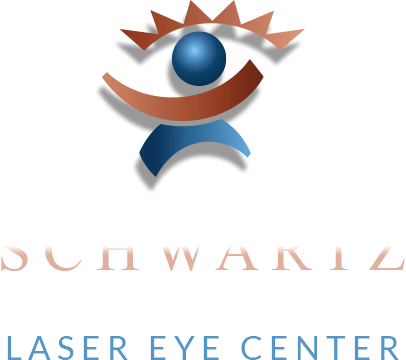 Committed to staying at the forefront of advances in intraocular lens (IOL) technology, Dr. Jay Schwartz and the team at Schwartz Laser Eye Center are pleased to offer the AcrySof IQ PanOptix, which is the first and only trifocal lens available in the United States. Dr. Schwartz is one of the first doctors in Arizona to implant the PanOptix in patients who want clear vision at all distances after cataracts.
Committed to staying at the forefront of advances in intraocular lens (IOL) technology, Dr. Jay Schwartz and the team at Schwartz Laser Eye Center are pleased to offer the AcrySof IQ PanOptix, which is the first and only trifocal lens available in the United States. Dr. Schwartz is one of the first doctors in Arizona to implant the PanOptix in patients who want clear vision at all distances after cataracts.
This revolutionary IOL provides a comfortable and continuous range of near, intermediate and distance vision without the need for glasses after surgery. It was designed with today’s active adult in mind, and enables the vision people need to carry out their daily tasks. Clinical studies show patient satisfaction is outstanding; in one study, 99 percent of PanOptix patients said they would select the same lens again, if given the choice.
Understanding How the PanOptix IOL Works
 The PanOptix lens focuses light entering the eye onto the retina, which then transmits the information from the eye to the brain. It enables clear vision at near, intermediate and faraway distances without gaps in between. Objects at various distances look sharp , colors look brighter and more vivid, and there are no blurry zones.
The PanOptix lens focuses light entering the eye onto the retina, which then transmits the information from the eye to the brain. It enables clear vision at near, intermediate and faraway distances without gaps in between. Objects at various distances look sharp , colors look brighter and more vivid, and there are no blurry zones.
Before the advent of trifocal IOLs, there were two other main types of IOLs: those that restored vision at a single fixed distance (requiring patients to wear glasses to see clearly at other distances), and those that restored clear vision at near and far distances, with a drop-off in intermediate distance. Intermediate distance is crucial — it allows one to see objects at arm’s length (e.g., a tablet or smartphone). Patients with other types of IOLs often complained that they could read a book at a close distance or see faraway objects, but they couldn’t see their computer screen or send a text on their smartphone.
 With the PanOptix, patients enjoy the vision they need for their many daily activities, including the following:
With the PanOptix, patients enjoy the vision they need for their many daily activities, including the following:
- Sending a text
- Watching television
- Reading a book
- Cooking
- Driving
- Gardening
- Sewing
- Playing sports
- Exercising
Not only is the range of vision larger with the PanOptix IOL, but patients report fewer side effects than with other types of IOLs. For example, patients with the PanOptix IOL say they have fewer occurrences of bothersome glare around bright lights, which can be common with other types of IOLs.
The PanOptix is available with technology to treat pre-existing astigmatism, which is a vision condition in which the cornea is abnormally curved and causes blurry vision and other visual symptoms. According to Alcon, the makers of the PanOptix IOL, approximately 70 percent of people with cataracts also have astigmatism. The PanOptix comes in a toric version specifically for patients with astigmatism.
Placement and Recovery
The surgery to remove a cataract and replace the lens with the PanOptix IOL normally takes about 10 to 20 minutes. The surgical recovery is quite short, and most people resume driving, working and the rest of their daily activities within a few days.
PanOptix® FAQs
What makes the PanOptix lens so special?
![]() AcrySof IQ PanOptix® intraocular lenses are the first IOLs to offer trifocal vision, providing clear focus at near, intermediate and far distances. Before the advent of PanOptix, choices were limited to monofocal options or lenses that offered two fixed ranges of vision. Significantly, Dr. Schwartz is among the first ophthalmologists in the state to make this advanced option available to cataract surgery patients.
AcrySof IQ PanOptix® intraocular lenses are the first IOLs to offer trifocal vision, providing clear focus at near, intermediate and far distances. Before the advent of PanOptix, choices were limited to monofocal options or lenses that offered two fixed ranges of vision. Significantly, Dr. Schwartz is among the first ophthalmologists in the state to make this advanced option available to cataract surgery patients.
Although new to the American market, PanOptix has established a solid track record around the world, with a documented satisfaction rate of 99 percent. According to the PanOptix FDA registration study, 20/20 vision or better is a likely outcome at near, far and intermediate distances for most patients.
What is unique about the focal points used by PanOptix lenses?
PanOptix achieves optimal vision across a range of distances by splitting light into three focal points: The intermediate focal point is 60 cm, which is within the optimal range established by the U.S. Occupational Safety and Health Administration for performing tasks using digital screens. This is more practical than the 80 cm focal point used by some other lenses. The near vision focal point is 40 cm, an ideal distance for reading and other close-range tasks. The third focal point is infinity, allowing clear, panoramic views of the world around you.
Isn’t putting something artificial in my eye risky?
There are no real negatives to replacing clouded cataracts with PanOptix or any other type of IOL. These lenses are designed to become a permanent part of your eye. They will not be rejected by your body or wear out. And because they are made of strong and resilient material, they should remain clear for a lifetime.
Are the results immediate?
In just a few days after cataract surgery and the implantation of your new lenses, you’ll have very good distance vision and will be able to resume your daily routine. With advanced IOLs such as PanOptix, it takes longer for your eye and brain to coordinate signals received via the new lenses. It’s a learning process that may take several weeks, and mostly affects near vision.
The healing process begins at different times for each eye, as Dr. Schwartz operates on one eye at a time, which is standard medical practice. The interval between surgeries varies from one to four weeks.
As your eyes recover, you will likely experience some sensitivity to bright lights in the short-term, but it will not affect your ability to drive or see at night. Any occurrence of glare, rings or rays around lights, or reduced contrast sensitivity that persists, may be a side effect that needs to be addressed by your ophthalmologist.
Will my prescription change in the future?
Although PanOptix IOLs are adept at imitating biological lenses, there is one area in which they do not: Unlike natural lenses, your vision will not typically fluctuate over time. Your prescription should stay the same, assuming good eye health.
Learn More about the PanOptix IOL
For more information about the PanOptix IOL, Dr. Schwartz invites you to schedule a consultation at one of our offices. Please request an appointment at Schwartz Laser Eye Center by calling 480-483-3937 or 888-553-3937, or by sending us an email.



